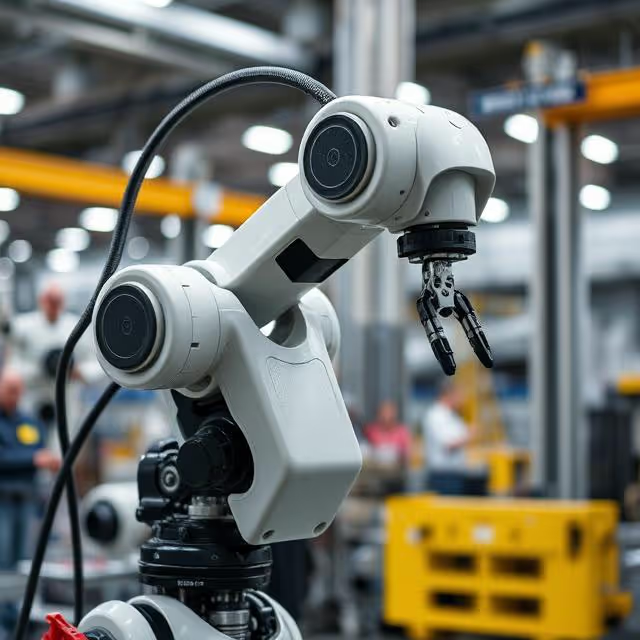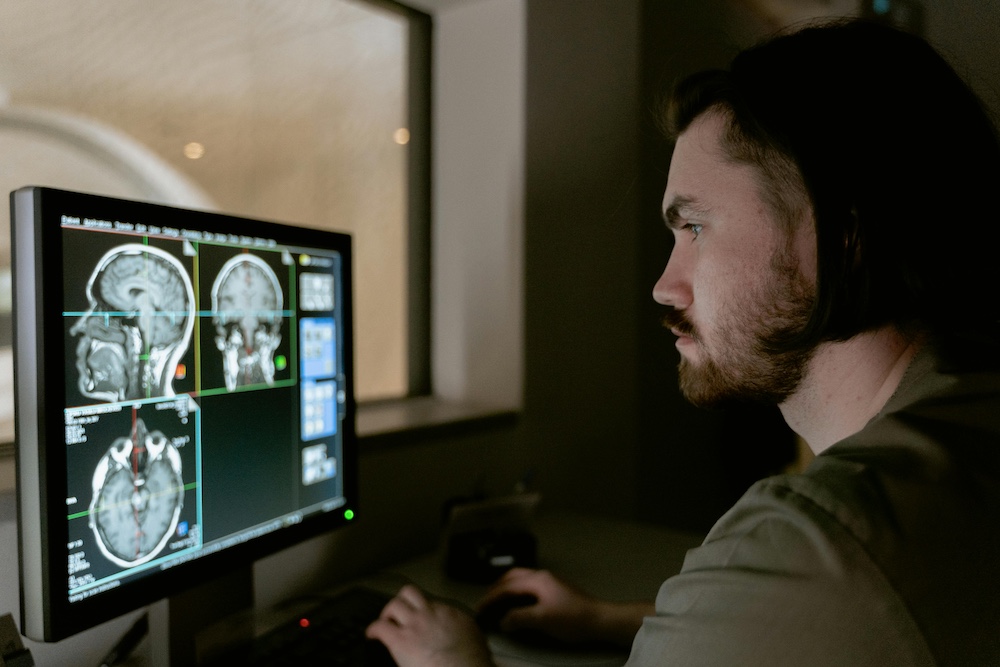Why Annotate Industrial Robots? 📈
At first glance, a robot arm in a factory doesn’t seem like something that needs to be labeled—it’s already controlled, right? But for AI systems that monitor, assist, or collaborate with these robots, visual understanding is essential. Here's why:
- Behavioral prediction: Annotated data enables machine learning models to predict robot behavior and prevent accidents.
- Process optimization: AI can analyze movement efficiency or detect anomalies in robot tasks.
- Human-robot collaboration: Vision models ensure robots don’t collide with human workers by recognizing limb movement, gestures, and proximity.
Whether you're training AI to monitor robotic workflows or enabling dynamic robot-to-robot coordination, annotation is the linchpin.
The New Vision of Smart Factories
Smart factories are no longer just about automation—they’re about intelligent orchestration of machines, people, and processes. Powered by sensors, edge computing, machine learning, and vast streams of labeled data, today’s factories function more like data centers with moving parts than traditional assembly lines.
From Hardwired Sequences to Adaptive Systems
In older manufacturing paradigms, robots were programmed to repeat static movements. A slight deviation—like a misplaced object—could bring production to a halt. Now, annotated visual data allows AI to dynamically adapt to what it sees:
- A robot arm can identify if a component is misaligned and adjust its grip in real time.
- Quality assurance systems can flag defects during assembly by recognizing patterns, not just checking boxes.
- AI systems can collaborate across stations, adjusting task timing based on real-time visual cues.
This level of adaptability is only possible when machine vision systems are trained on high-quality, context-aware annotations that help the AI understand what's happening—not just what exists.
The Rise of Human-Centric Automation
Contrary to the myth that robots replace humans, smart factories aim to make humans safer, faster, and more focused. Annotated data plays a key role here:
- Augmented reality overlays powered by AI can assist workers with visual instructions based on object recognition.
- Cobots use annotated datasets to predict human movement and avoid accidents while working alongside employees.
- Worker fatigue detection systems use facial expression and posture data to intervene before accidents occur.
In this hybrid vision, annotation isn’t just about robots—it’s about enabling harmonious machine-human synergy where both collaborate with shared visual intelligence.
Visual Data as the Factory’s Nervous System
In a smart factory, annotated video streams are as vital as electricity. Each camera, drone, or robot-mounted lens serves as a sensor feeding the central AI brain. With robust labeled datasets:
- Workflows are tracked across entire lines.
- Bottlenecks are identified before they escalate.
- Equipment usage is optimized through behavioral analysis.
This means annotation isn’t just a preprocessing step—it’s the strategic enabler of intelligent operations.
📊 According to Capgemini, over 40% of manufacturers deploying AI in smart factories report increased operational efficiency and decreased risk exposure. The secret? High-quality annotated data.
Common Annotation Targets in Industrial Robotics 🎯
When annotating robotic systems, it’s not just about bounding boxes around metal arms. The focus often shifts to:
- Joints and articulation points
For analyzing movement fluidity or detecting mechanical wear. - End effectors (tools at the end of robot arms)
Like welding torches, suction cups, grippers—these define the robot’s action. - Workspace zones
Highlighting safety zones, danger zones, or restricted areas for AI monitoring. - Interaction points
Where a robot makes contact with an object, another robot, or a human. - Motion sequences
Frame-by-frame labeling of complex actions like palletizing, screwing, or component inspection.
These granular targets form the visual data foundation for teaching models about robotic behavior and movement logic.
Temporal Annotation: Movement in Motion 🎞️
Industrial robots don’t just exist—they act. They lift, rotate, weld, sort, and collaborate. Capturing these actions over time is the essence of temporal annotation—a core requirement for building motion-aware AI systems.
What Is Temporal Annotation?
Temporal annotation involves labeling sequences across multiple frames to capture:
- Object trajectories: How a robot or component moves across time
- Stage-based activities: Start, midpoint, and end of a complex task (e.g., pick → lift → rotate → place)
- Behavior patterns: Motion fluency, hesitation, repetition, or anomalies
This type of annotation transforms passive video into a dynamic timeline of intelligent events, enabling time-aware AI that can “understand” unfolding situations.
Practical Applications in Robotics
- Welding Arms: Annotating the full arc path and speed of a welding robot can help optimize weld quality and detect tool degradation.
- Sorting Robots: Tracking the time taken between pick and place actions helps optimize latency and reduce errors.
- Assembly Lines: Annotating sequence stages like “grasp,” “insert,” and “lock” across frames allows AI to validate correct task execution.
For example, in a high-speed electronics assembly, if the AI model is trained only on still images, it may miss the timing deviation that signals a mechanical fault. But with temporal annotations, it can detect that a screw was inserted 0.3 seconds too late—often the difference between flawless output and product failure.
Techniques That Power Temporal Annotation
- Object Tracking: Assigning unique IDs to robots or components to track their movement over time.
- Pose Estimation Across Frames: Using skeletal mapping to annotate robotic joints and detect deviations in movement arcs.
- Action Segmentation: Dividing sequences into labeled chunks: e.g., “approach,” “engage,” “retract.”
🔗 Curious to see this in action? Check out ActivityNet—a benchmark dataset that applies temporal segmentation for activity recognition.
Challenges Unique to Temporal Workflows
- Frame Accuracy: High-speed movements require high-frame-rate cameras to ensure annotation precision. Missing a single frame could misrepresent an entire action.
- Synchronization: Temporal annotation often involves multi-view data (e.g., front and top camera views) that must be time-aligned to ensure consistent labeling.
- Event Ambiguity: Unlike clear-cut object boundaries, motion boundaries can be fuzzy—where exactly does “rotate” end and “place” begin? Annotators must be trained to use consistent logic.
Value Unlocked
Temporal annotations allow factories to:
- Detect early signs of wear or failure in robot movement
- Build motion prediction models for real-time decision-making
- Enable automated visual QA where the AI compares expected vs. actual movement sequences
- Train AI for autonomous process control, minimizing human intervention
🧠 Temporal annotation turns robot vision from reactive to proactive—helping machines predict, prevent, and perfect their operations.
Multi-Modal Data Fusion: Beyond Just Vision
Modern robotic systems don’t rely solely on cameras. They integrate:
- LiDAR or depth sensors for spatial awareness
- Thermal cameras to detect overheating or abnormal temperature changes
- Force sensors and torque data for precision interaction
- Audio in certain inspection scenarios
Annotations must align across these modalities. For example, aligning visual trajectory with force feedback can help determine if a robot is pressing too hard or missing its grip.
This multimodal annotation demands time-synced labeling and tight integration between different sensor streams—an advanced but increasingly necessary practice.
Key Use Cases Driving Demand
The need for robot annotation is growing across multiple verticals. Here are some real-world applications:
Predictive Maintenance
AI models trained on annotated robot behavior can detect early signs of joint fatigue, misalignment, or speed inconsistencies—triggering proactive maintenance before failure.
🛠️ Example: Annotating motion lag in robotic arms during repetitive assembly reveals actuator issues invisible to traditional logs.
Cobots and Human-Robot Interaction (HRI)
As collaborative robots (cobots) become common, AI must track both robot and human limbs in real time to ensure safety.
👷♀️ In these scenarios, annotations capture joint angles, hand gestures, and proximity alerts to prevent collisions.
Quality Control and Inspection
AI-powered vision systems inspect whether robots perform tasks accurately. Misalignments, missing welds, or defective assembly actions can be detected by comparing real-time video with annotated reference movements.
Assembly Line Optimization
By studying annotated movement patterns, AI can suggest faster paths, reduced idle times, or better tool configurations.
📉 Bosch claims to have cut 15% of cycle time on some lines using annotated robot performance analysis.
What Makes Robot Annotation So Challenging? ⚠️
Unlike annotating cats or cars, labeling industrial robots involves unique challenges:
Reflective Surfaces and Occlusions
Robots are often metallic and operate in harsh lighting. Reflections and lens flare cause false positives unless datasets are carefully curated.
Speed Variability
Some robots move in milliseconds. Annotators must capture ultra-fast transitions—requiring high-frame-rate footage and tools that support frame interpolation.
Repetitive Yet Subtle Variance
Though robots repeat tasks, tiny deviations (e.g., arm jitter) can signal major faults. Annotation must be precise enough to distinguish between normal repetition and faulty behavior.
Multi-Camera Syncing
Many setups use overhead, side, and front-view cameras to track full robot range. Annotating across all views simultaneously—while keeping labels aligned—is no trivial task.
Strategies for Scalable Annotation Workflows 🧠
To build large, reliable datasets for industrial robot AI, follow these best practices:
Define Clear Movement Taxonomies
Develop a standardized vocabulary for robot actions:
- Pick, place, weld, rotate, press, idle, abort, etc.
This ensures consistent annotation even when tasks evolve.
Leverage Synthetic Data for Rare Scenarios
Not every failure or dangerous event can be captured naturally. Synthetic video generation helps fill gaps by simulating faults, abnormal movements, or edge cases.
🔗 Learn more: NVIDIA Omniverse for synthetic robotics data.
Automate with Model-in-the-Loop
Train a weak model early, use it to pre-label new data, and let human annotators correct rather than label from scratch. This dramatically speeds up throughput.
Use Task Decomposition
Break complex robot sequences into sub-tasks: e.g., reach → grip → lift → rotate → place. Annotators handle micro-actions more accurately and models learn faster.
Integrating Annotated Robot Data into AI Pipelines
Once annotated, how does the data translate into real-world AI solutions?
Training Deep Learning Models
Annotated sequences train models to classify, segment, or predict robot actions. They’re especially valuable in training:
- Action recognition networks
- Pose estimation models
- Anomaly detection systems
Enabling Edge AI on Factory Floors
Labeled data fuels lightweight inference models deployed on edge devices (e.g., NVIDIA Jetson) that operate in real time to monitor or guide robots.
⚙️ For example, annotated data trains a vision model that alerts operators when a robot enters an unauthorized zone.
Feedback Loop for Continuous Learning
Annotations also power reinforcement learning setups, where robotic AI improves through real-world trial, error, and human-labeled feedback.
Emerging Trends to Watch 🌐
The industrial robotics space is moving fast, and annotation must keep up. Here are trends reshaping the field:
Self-Annotating Robots
Some robots now generate logs or visual overlays of their own movements—serving as auto-annotation sources. These can be aligned with external camera feeds for hybrid labeling.
Augmented Reality for Annotation Review
AR tools allow engineers to review and correct annotations overlaid directly on live factory feeds or simulations, making quality checks more intuitive.
Federated Annotation and Privacy
As factories protect proprietary robot movements, federated learning enables model training without sharing raw annotated data. Labeling workflows must adapt to secure environments.
Real-World Example: Annotating Spot the Robot Dog 🐕
Boston Dynamics' Spot is being adopted for factory inspections, often with AI vision modules. Annotating Spot’s gait, poses, and interactions enables AI to:
- Recognize unsafe walking conditions
- Detect when Spot deviates from patrol routes
- Analyze wear or limp patterns over time
In such cases, annotation covers skeletal motion, surface contact points, and even terrain classifications.
Why It Matters: The ROI of Annotating Robot Movements 💡
The value of annotation lies in the ROI it unlocks:
- Lower accident rates due to predictive safety systems
- Higher output via motion optimization
- Reduced downtime through anomaly detection
- Future-proof datasets for next-gen AI
Every labeled frame becomes a building block in an AI-driven factory that’s faster, safer, and smarter.
Let’s Make Your Robots Smarter Together 🚀
If you’re building AI models for robotic automation, don’t let poor labeling hold you back. The right annotation strategy can transform your production line insights from “mechanical” to “intelligent.”
💬 Whether you're training models for robot detection, monitoring, or optimization—our annotation experts at DataVLab can help you scale reliably and securely.
Get in touch today and let’s talk about powering your robotics vision with precision.





